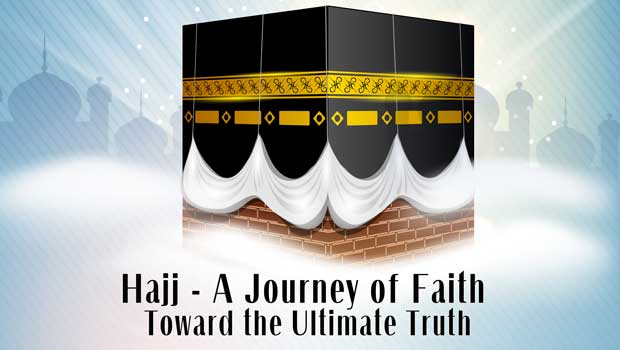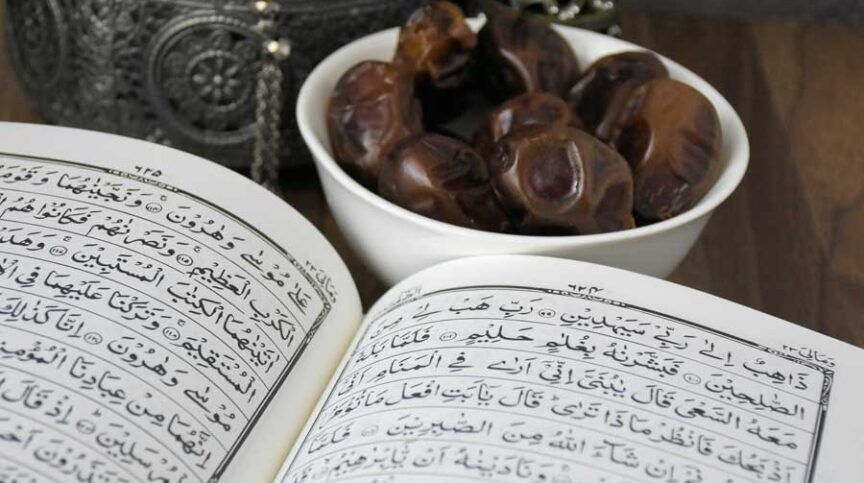The journey of Hajj (Islamic pilgrimage) begins with niyah (intention), by cleansing the body and, for the man, wearing the ihram, two pieces of cloth without any stitchingordecoration on it. A woman wears additional garments in order to cover her awrah (the intimate parts of the body), as prescribed in the Quran. As the journey begins, the pilgrim declares the Talbiyah, the prayer of intention to perform the Hajj and doing so only for the glory of Allah: “Here I am at Your service, O Lord, here I am. Here I am at Your service and You have no partners. Verily all praise and all bounty and the sovereignty are Yours. You have no partners.”
The obligatory rituals of Hajj commence on the 9th day of Dhul-Hijjah (the twelfth and final month in the Islamic calendar) by arriving at any point within the boundaries of the plain of Arafah in Makkah Al-Mukarramah (the holy city of Makkah) before sunset. Even if it is only for a moment, standing in Arafah on that day before sunset is the beginning of one’s Hajj. The next obligatory part of the journey continues immediately after sunset, the journey towards Muzdalifah, a large level area southeast of Makkah. At least one third of the night needs to be spent under the open sky at Muzdalifah. Then the pilgrim chooses the next part of the journey, either to go to Mina or to the Al-Masjid-al- Haram. Those who choose to go to Mina first will eventually have to go to Al-Masjid-al- Haram and continue the journey by tawaf (circumambulation) seven times around the Ka’ba,the House of Allah and the first masjid on the earth,built by Prophet Ibrahim. Upon completion of tawaf, the pilgrims continue the journey with a ritual named Saii, marching seven times between Safa and Marwa, two mountains near the Ka’ba. Part of the journey includes throwing stones at the jamarat, three pillars where Satan is said to be tied. In addition to these, at least three nights can be spent at Mina and a qurban,sacrifice, can be offered (not obligatory).
In Hajj, each and every ritual is a reminder of a Muslim’s relationship with Allah. The ihram is a reminder of the return to the Rabb (Lord and Creator), as it is similar to the shroud that will be worn after death, for burial in the kubur (grave). Standing on Arafah is a reminder of Allah forgiving Prophet Adam and his wife Hawa, and where mankind began their journey on earth. Saii is the remembrance of the event when Hājar, the second wife of Prophet Ibrahim, accepted to stay in the middle of desert with her baby without any apparent supply of food or shelter, following the command of Allah. Spending a night in the desert of Muzdalifah under the open sky is a reminder of the minuscule existence of a human entity in the universe. Throwing stones at Jamarat is reminder of Prophet Ibrahim’s encounter of Satan and throwing stones to get rid of the Satanic influence so that he can obey Allah. The event of qurban is linked to Prophet Ibrahim’s intention to sacrifice his most beloved son for the sake of Allah.
Thus, the journey of Hajj is a reminder of the concept of tawhid (oneness of Allah) in every dimension. The journey reminds us that Allah is the Creator of the heavens and the earth and everything in between, that only Him we worship and obey, and that to Him we all are bound to return. And a pilgrim declares that by reciting the Talbiyah as a testimony of surrender to Him at the beginning of Hajj.
While performing Hajj, a pilgrim has utmost faith that Allah, the most Merciful and the Most Kind, will forgive all his past sins and will grant His blessings for success in the life hereafter. Those who are yet to perform Hajj, also have similar faith about receiving His forgiveness and blessings if they would have the chance to perform Hajj. Hence, while performing the rituals, every pilgrim dedicates their utmost and sincere effort to complete the journey without any mistakes,and an unintentional mistake is corrected by offering various forms ofkafarah(expiation).
Faith and Dedication During Hajj Reflected in Daily Life
Is the level of faith and dedication of a pilgrim during Hajj reflected in the daily life of a Muslim? Regardless of the pledge and effort we all make, we are bound to have shortcomings or sins in the ongoing journey of our daily lives. Besides, many of us might not have the opportunity to perform Hajj before we return to our Rabb. Therefore, the faith and dedication that a Muslim demonstrates while performing Hajj, i.e., having the journey to Arafah, Muzdalifah, Mina, Tawaf, Saii, and throwing stones at Jamarat, are meant to be observed every moment in the everyday life.
To evaluate our level of faith in our daily life, compared to the level of faith that we have during the Hajj, let us exemplify saii, an important ritual of Hajj. Saii reminds us how Nabi (Prophet) Ibrahim and his second wife Hājar submitted themselves to the command of Allah (Quran, 14: 37). Based on human understanding or rationality, both Nabi Ibrahim and Hājar knew the absurdity of finding water, food, and shelter in the middle of that desert. Such facts, which are based on human calculation — observation or rationality — would force them to believe that the mother and the baby would not survive in the desert. However, their submission was guided by their faith in the oneness of Allah who creates everything out of nothing and that only He controls everything on earth and in the heavens and everything in between (Quran, 39: 62). Thus, their obedience to the command of Allah based on their faith in the ultimate truth demonstrates how Allah can contravene natural law, according to His will and pleasure, for He transcends the very laws of nature that He put in place in the universe. The obedience of Ibrahim and Hājar to His command also provides a lesson for all time about the beauty and power found in the depth of faith that a true believer possesses. That is the level of faith we should strive for in our daily lives.
At various times throughout history, Allah sent a prophet and messenger to a particular ummah (nation, race, or tribe). All the prophets called their respective ummah toward tawhid, oneness of Allah (Quran 51:56). Thus, every prophet called for his people to accept and declare the same testimony of tawhid: “There is no god but Allah.” To live life on the right path, mankind has been reminded of the same ultimate truth again and again. A Muslim today must embark on the journey of life towards the ultimate truth. The reality of tawhid,oneness of Allah, is true in every aspect of the universe including human life. The testimony to that reality expresses that Allah is the Creator and sole master of everything in the heavens and earth and everything in between.
Prophet Mohammad, like every other prophet before him, taught his ummah the ultimate truth,that there is no god but Allah. By accepting Mohammad as the last prophet and messenger of Allah, the people of his time accepted the oneness of Allah.Since then, those who have accepted this ultimate truth have been guided in their journey of life on the straight path; and those who denied this truth have remained astray (Quran 48:29). Those who accept the ultimate truth enter the sanctuary of Islam and become Muslim (Figure 1).Indeed, Allah asks every human being to become a Muslim before they die (Quran 3:102). Upon accepting the ultimate truth, a Muslim starts his journey toward full conviction as a believer (Mu’min), one who not only accepts and declares the ultimate truth but also acts accordingly.
There are more than 80 verses in the Quran that command the Mu’min to lead their life according to the precepts of truth and goodness. In reality, not every Muslim can follow all of Allah’s commands in his lifetime. Despite the differences in the paths taken by Muslims for their journey toward the ultimate truth, everyone must remain determined to follow the command of Allah (Figure 1). At the same time, he or she must aim for excellence in performing their obligations and become a successful Mu’min (Quran 23:1-10). For example, such a successful Mu’min not only establishes salat, but also offers salat with due solemnity and full submissiveness, turns away from al-laghw (dirty, false, or evil vain talk, falsehood, and all that Allah has forbidden), and guards their chastity.
Conclusion
Hajj is a journey of faith toward the ultimate truth. It has its requirements, its rituals, and its rewards. It also has many important reminders for the believer that can be utilized to deepen iman, strengthen conviction, and imbue the Muslim’s devotion with meaning and purpose. Standing on the path toward the ultimate truth, with the faith and dedication of a pilgrim, an individual takes great care in determining what is right or what is wrong,what is good or bad, useful or useless, beneficial or harmful. Deep in his or her heart is the meaning and purpose of both the shahadah and the talbiyah —that we have full conviction that Allah is one, with no partners, that we are here to serve Him, and that any bounty we enjoy in our lives is from Him, and Him alone. And, finally, in His sovereignty, He alone is worthy of all praise.
Acknowledgement: I gratefully acknowledge invaluable suggestions from Associate Prof. Dr. Raihanah Binti Hj Azahari (Academy of Islamic Studies, University of Malaya), Dr. Mohammad Bahawi (University of Jeddah), and Hatim Abdullah Natto (Umm-al-Qura University) in writing this article.





